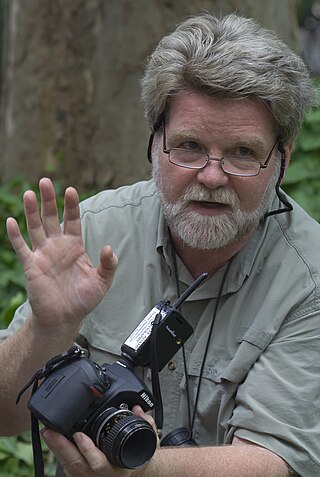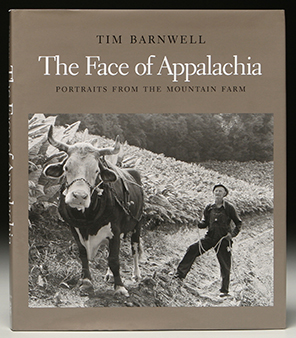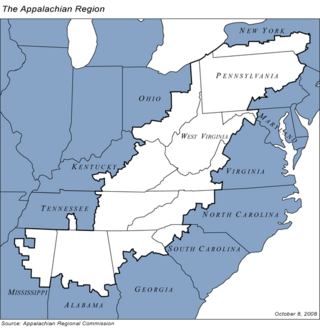
Appalachia is a geographic region located in the central and southern sections of the Appalachian Mountains of the eastern United States. It stretches from the western Catskill Mountains of New York state into Pennsylvania, continuing on through the Blue Ridge Mountains and Great Smoky Mountains into northern Georgia and Alabama. In 2021, the region was home to an estimated 26.3 million people, of whom roughly 80% were white.

The Blue Ridge Parkway is a National Parkway and All-American Road in the United States, noted for its scenic beauty. The parkway, which is the longest linear park in the U.S., runs for 469 miles (755 km) through 29 counties in Virginia and North Carolina, linking Shenandoah National Park to Great Smoky Mountains National Park. It runs mostly along the spine of the Blue Ridge, a major mountain chain that is part of the Appalachian Mountains. Its southern terminus is at U.S. Route 441 (US 441) on the boundary between Great Smoky Mountains National Park and the Qualla Boundary of the Eastern Band of Cherokee Indians in North Carolina, from which it travels north to Shenandoah National Park in Virginia. The roadway continues through Shenandoah as Skyline Drive, a similar scenic road which is managed by a different National Park Service unit. Both Skyline Drive and the Virginia portion of the Blue Ridge Parkway are part of Virginia State Route 48 (SR 48), though this designation is not signed.

Great Smoky Mountains National Park is an American national park in the southeastern United States, with parts in North Carolina and Tennessee. The park straddles the ridgeline of the Great Smoky Mountains, part of the Blue Ridge Mountains, which are a division of the larger Appalachian Mountain chain. The park contains some of the highest mountains in eastern North America, including Clingmans Dome, Mount Guyot, and Mount Le Conte. The border between the two states runs northeast to southwest through the center of the park. The Appalachian Trail passes through the center of the park on its route from Georgia to Maine. With 13 million visitors in 2023, the Great Smoky Mountains National Park is the most visited national park in the United States.

Doris Ulmann was an American photographer, best known for her portraits of the people of Appalachia, particularly craftsmen and musicians, made between 1928 and 1934.

Appalachian music is the music of the region of Appalachia in the Eastern United States. Traditional Appalachian music is derived from various influences, including the ballads, hymns and fiddle music of the British Isles, and to a lesser extent the music of Continental Europe.

The Museum of Appalachia, located in Norris, Tennessee, 20 miles (32 km) north of Knoxville, is a living history museum that interprets the pioneer and early 20th-century period of the Southern Appalachian region of the United States. Recently named an Affiliate of the Smithsonian Institution, the museum is a collection of more than 30 historic buildings rescued from neglect and decay and gathered onto 63 acres (25 ha) of picturesque pastures and fields. The museum also preserves and displays thousands of authentic relics, maintains one of the nation's largest folk art collections, and hosts performances of traditional Appalachian music and annual demonstrations by hundreds of regional craftsmen.

Jonathan Williams was an American poet, publisher, essayist, and photographer. He is known as the founder of The Jargon Society, which has published poetry, experimental fiction, photography, and folk art since 1951.

Southern Highland Craft Guild is a guild craft organization that has partnered with the National Park Service for over seventy years. The Guild represents over 800 craftspeople in 293 counties of 9 southeastern states. It operates four retail craft shops and two annual craft expositions which represent the Guild members' work. These expositions occur in July and October and have taken place in the Appalachian mountain region since 1948.

Shelby Lee Adams is an American environmental portrait photographer and artist best known for his images of Appalachian family life.

Cataloochee is a valley in the Great Smoky Mountains of North Carolina, located in the Southeastern United States. Now a recreational and historic area within the Great Smoky Mountains National Park, Cataloochee was once home to a substantial Appalachian community and Cherokee hunting ground.
Lee Sexton was an American banjo player from Letcher County, Kentucky. He began playing the banjo at the age of eight and was proficient in the two-finger picking and "drop-thumb" (clawhammer) traditional styles of east Kentucky. He also sang and played fiddle. His Whoa Mule album includes recordings from a 1952 home recording with fiddler Fernando Lusk to recordings made in 2001. Four solo songs also appear on Smithsonian Folkways album Mountain Music of Kentucky.

The Folk Art Center is a museum of Appalachian folk art and crafts located at milepost 382 on the Blue Ridge Parkway near Asheville, North Carolina. It also houses offices for three separate Parkway partners: the Southern Highland Craft Guild, the National Park Service, and Eastern National.

Wendy Ewald is an American photographer and educator.

Leah Song is an American singer-songwriter, multi-instrumental musician, storyteller, poet, artist, and activist known for her role as one of the two frontsisters of Rising Appalachia — with younger sister Chloe Smith — incorporating sultry vocals, rhythm, banjo, guitar, ballads, dance, spoken-word and storytelling into her work. Her music is based in the traditions of Southern soul and international roots music.

The Face of Appalachia: Portraits from the Mountain Farm is a 2003 hardcover book by photographer and author Timothy Lee Barnwell. It is a mixture of photography and oral history text about the culture of Appalachia. It was first published on December 17, 2003 W.W. Norton and includes over 100 black and white photographs as well as interviews with the Appalachia inhabitants depicted.

Hands in Harmony: Traditional Crafts and Music in Appalachia is a 2009 photography book by photographer and author Timothy Lee Barnwell. It was first published on October 12, 2009 by W.W. Norton and, like Barnwell's prior works, focuses on the culture and history of Appalachia. Its contents focus on the traditions of hand crafts and on old-time and bluegrass music, and it contains photographs of Barnwell's interviewees as well as an accompanying CD of bluegrass music.
Charles Counts (1934–2000) was an American potter, designer, textile artist, quilter, teacher, writer, and activist. Counts worked to preserve the art forms of his native Appalachia, and later moved to Nigeria where he taught until his death.
Rob Amberg is a North Carolina photographer, folklorist, and chronicler of a small Madison County mountain community, Revere, North Carolina, which he depicted in his long-term photo project Sodom Laurel Album. Amberg anticipated the completion of highway I-26 from Charleston, South Carolina, to the Tennessee Tri-Cities area and, starting in 1994, began photographing, interviewing, and collecting objects to document the cutting of a nine-mile stretch of I-26 through some of North Carolina's most spectacular vistas and some of the world's oldest mountains—a project which contributed to the publication of his book The New Road. His documentary photography is archived in a collection at Duke University Library.

Appalachian folk art is a regional form of folk art based in the Appalachian region in the United States. In an article about the contemporary form of this art, Chuck Rosenak stated, "the definition of folk art is obscure". Folk art is a way to convey the feelings and mannerisms of cultures through handmade visual art and communicates a message to the observer. Though folk art itself was brought to the Americas by Europeans, it has adapted to each region and has cultivated traditions in each region.















